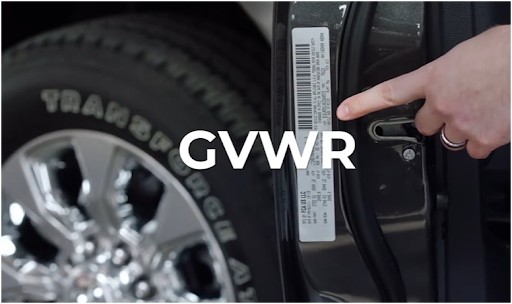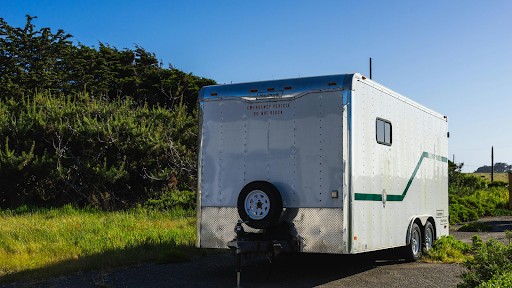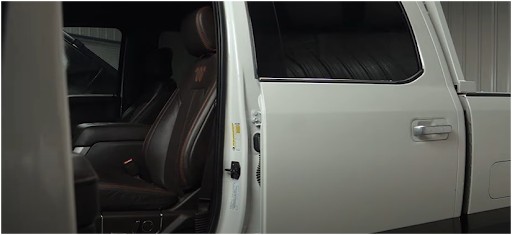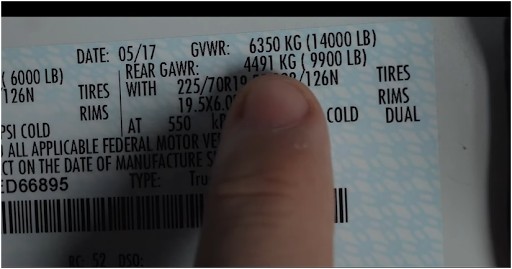Alright, confession time: I once hit the road with my RV trailer, feeling like I had everything under control. The gear was packed, the trailer was loaded, and I was ready for a weekend of boondocking bliss. But then, I pulled into a gas station, checked the weight limits, and realized I had no clue about the GVWR on my trailer. Cue the panic. Was I pushing my trailer beyond its limits? Was I putting my safety (and my adventure) at risk? Turns out, there’s a reason why understanding the GVWR on a trailer is so crucial.
It’s more than just a number stamped on a label—it’s the key to safe towing, proper weight distribution, and avoiding some serious (and expensive) mistakes. But don’t worry, I’ve got you covered. Let’s break down what GVWR really means and how you can use it to ensure your trailer experience is smooth sailing.
What is GVWR on a Trailer?
 Image source- Weigh Safe
Image source- Weigh Safe
GVWR stands for Gross Vehicle Weight Rating, and it’s a manufacturer’s guideline that tells you the maximum total weight your trailer can safely carry.
This includes the weight of the trailer itself, any cargo or equipment, and any additional accessories you may have added. Simply put, the GVWR is the upper limit of how much weight your trailer can handle without compromising safety. It’s essential to understand this number because it helps protect your trailer’s components—from the frame to the axles to the suspension. Exceeding the GVWR could lead to catastrophic failure, leaving you stranded or causing damage to your vehicle or trailer.
How is GVWR Different from Towing Capacity?

Okay, here’s where it gets a little confusing: GVWR isn’t the same thing as your vehicle’s towing capacity. While they’re both related to weight, they measure different things.
- GVWR on a trailer is specific to the trailer itself, including its curb weight (the trailer’s weight when it’s empty) and the weight of whatever you’re hauling. It’s all about what the trailer can handle safely.
- Towing capacity, on the other hand, is the maximum weight your tow vehicle can safely pull. It includes the weight of the trailer itself and anything on it, so it’s important to know both numbers.
Let’s say your trailer has a GVWR of 10,000 lbs, and your tow vehicle can handle a maximum of 12,000 lbs. If you’re hauling that full 10,000 lbs, you’re well within the tow vehicle’s limit—but you have to make sure the trailer isn’t overloaded, too. Always check both the GVWR of your trailer and the towing capacity of your vehicle to keep everything in check.
Why Should You Care About the GVWR on Your Trailer?
 Image source- All About Trailers
Image source- All About Trailers
the deal: the GVWR on a trailer isn’t just a random number—it’s a safety measure that helps ensure your trailer’s frame, axles, suspension, and tires can handle the weight. Exceeding the GVWR can cause a range of problems, from blown tires to axle damage to unpredictable handling.
Let’s say you’re hauling a cargo trailer with heavy construction equipment. If you load the trailer up to its GVWR limit, you’re reducing the risk of damaging your trailer and maintaining stability during towing. But if you push past that limit? Well, you’re just asking for trouble. That’s when things can get dangerous—both for you and for everyone else on the road.
How Do You Find the GVWR on Your Trailer?
 Image source- All About Trailers
Image source- All About Trailers
The GVWR is usually listed on a sticker or label that’s prominently placed on your trailer. You’ll typically find it on the driver’s side of the trailer or near the tongue, often close to the VIN number. If you’re having trouble locating it, take a moment to check out the manual or look for a metal plate or sticker on the trailer frame.
Here’s the cool part: once you know your trailer’s GVWR, you can calculate the payload capacity—the maximum weight of cargo you can load onto the trailer. To do this, subtract the empty weight (or curb weight) of your trailer from the GVWR.
For example, if your trailer weighs 2,000 lbs and its GVWR is 10,000 lbs, you can safely load up to 8,000 lbs of cargo.
Also Read : Living in an Rv
How to Calculate Payload Capacity
Let’s walk through a simple example of how to calculate your trailer’s payload capacity. Say you’ve got a trailer with a GVWR of 10,000 lbs, and its curb weight is 2,500 lbs.
- GVWR = 10,000 lbs
- Curb weight = 2,500 lbs
- Payload capacity = GVWR – curb weight = 10,000 lbs – 2,500 lbs = 7,500 lbs
This means you can safely load up to 7,500 lbs of gear, equipment, or cargo without exceeding the trailer’s weight limit. Easy, right?
FAQ: What is GVWR on a Trailer?
Q: Can I exceed the GVWR on my trailer if I’m just driving around town?
A: It’s never a good idea to exceed the GVWR, even for short trips. Pushing past the weight limit can affect the handling, braking, and overall safety of your trailer. Stick to the GVWR to ensure you’re towing safely and don’t risk damaging your equipment.
Q: Does GVWR apply to all types of trailers?
A: Yes! Whether you’re hauling a boat, a utility trailer, or an RV, every trailer has a GVWR. It’s important to know the GVWR for all kinds of trailers because each one is designed to carry a specific amount of weight.
Q: How do I know if I’m close to exceeding the GVWR?
A: Always weigh your trailer and its contents. If you don’t have access to a scale, some truck stops and RV parks offer public weigh stations. If you’re unsure, check your trailer’s curb weight and calculate the payload capacity, then add up your cargo to make sure you’re not pushing the limit.
Final Scoop Before You Jump In: A Little Extra Caution Goes a Long Way
Now that you know the GVWR on a trailer, it’s time to take this knowledge with you next time you hit the road.
Whether you’re planning an epic boondocking adventure or just hauling some heavy-duty equipment, knowing your trailer’s limits will help you stay safe and avoid costly mistakes.
As for me, I never hit the road without checking my trailer’s weight first. It’s one less thing to worry about while I’m cruising the open road. Trust me—you’ll be glad you did!
So, take a deep breath, check that sticker, and get ready to hit the road knowing you’ve got the right gear and the right limits to keep things running smoothly. Happy travels!














